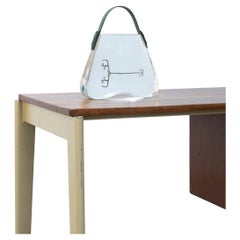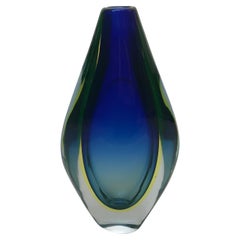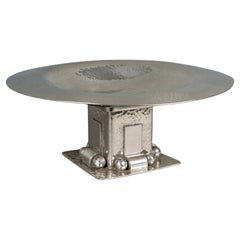Ted Noten Centerpieces
to
1
1
1
1
1
1
1
1
1
1
101
58
49
36
Creator: Ted Noten
Ted Noten “Carrying Architecture” Hommage to Jean Prouvé-Bag
By Ted Noten
Located in Tokyo, Tokyo
Ted Norton's work is based on a unique approach and profound concepts. He is particularly known for a series of handbag-shaped pieces, in which he encapsulates jewelry, small items, ...
Category
2010s Dutch Ted Noten Centerpieces
Materials
Acrylic
Related Items
Murano, 1950, Italian, Attributed to Flavio Poli
By Flavio Poli
Located in Ciudad Autónoma Buenos Aires, C
Murano
We have specialized in the sale of Art Deco and Art Nouveau and Vintage styles since 1982. If you have any questions we are at your disposal.
Pushing the button that reads 'Vi...
Category
1950s Italian Space Age Vintage Ted Noten Centerpieces
Materials
Murano Glass
Jean Despres Modernist Art Deco Center Centerpiece Silver Plated Hammered
By Jean Despres
Located in Boulogne Billancourt, FR
Modernist Art Deco Table Centerpiece made in hammered silver plated Jean Despres made in 1940s.
Engraved signature.
Perfect condition. Exceptional and unique model.
height: 14 c...
Category
1940s French Art Deco Vintage Ted Noten Centerpieces
Materials
Silver Plate
$38,484
H 5.52 in Dm 13.98 in
Murano, Attributed to Flavio Poli, Italian, 1940
By Flavio Poli
Located in Ciudad Autónoma Buenos Aires, C
Murano
We have specialized in the sale of Art Deco and Art Nouveau and Vintage styles since 1982. If you have any questions we are at your disposal.
Pushing the button that reads '...
Category
1940s Italian Art Deco Vintage Ted Noten Centerpieces
Materials
Murano Glass
Jean Puiforcat Modernist Art Deco Tureen Centerpiece Sterling Silver Vermeil
By Jean Puiforcat, Puiforcat
Located in Boulogne Billancourt, FR
Centerpiece - Art-Deco Modernist Center Piece - Tureen made in solid sterling silver and vermeil 950/1000th designed Jean E. Puiforcat created in 1937.
All parts are stamped Minverve...
Category
1930s French Art Deco Vintage Ted Noten Centerpieces
Materials
Sterling Silver
$76,376
H 10.63 in Dm 10.63 in
Brazilian Architectural Bowl Slatted Centerpiece Mid-Century like Oscar Niemeyer
By Oscar Niemeyer, Joaquim Tenreiro
Located in Hyattsville, MD
Made in Brazil, a hand-crafted footed centerpiece sculpture, truly an mid-century masterpiece. A fragile, brass belted, curved Jacaranda (Brazilian Rosewood) slat design. A rare find...
Category
1950s Brazilian Mid-Century Modern Vintage Ted Noten Centerpieces
Materials
Jacaranda
$5,520 Sale Price
20% Off
H 3.75 in Dm 14.5 in
Murano, 1930, Italian. Attributed to Carlo Scarpa
By Carlo Scarpa
Located in Ciudad Autónoma Buenos Aires, C
Murano
Attributed to Carlo Scarpa
We have specialized in the sale of Art Deco and Art Nouveau and Vintage styles since 1982. If you have any questions we are at your disposal.
Pushi...
Category
1930s Italian Art Deco Vintage Ted Noten Centerpieces
Materials
Murano Glass
Murano, 1940 . Attributed to Seguso - Barovier, Italian
By Barovier Seguso & Ferro
Located in Ciudad Autónoma Buenos Aires, C
Murano
Attributed to Seguso - Barovier
We have specialized in the sale of Art Deco and Art Nouveau and Vintage styles since 1982. If you have any questions we are at your disposal.
Pushing the button that reads 'View All From Seller'. And you can see more objects to the style for sale.
The history of "Seguso Vetri D' Arte" is directly linked to the "Vetreria Artistica Barovier" company. When the Barovier workshop was forced to reduce production in 1929, due to a financial crisis in America, the
original group of ten partners had to separate and Antonio Seguso in 1931, assisted by his sons Ernesto and Archimede opened a small workshop of his own. They were joined by Luigi Olimpio Ferro and Napoleone Barovier the following year. Together the craftsmen establish the "Artistica Soffieria e Vetreria Barovier Seguso & Ferro" company as equal partners.
In 1934 Flavio Poli joins the firm as artistic director and within only a brief period of time a distinct style of designs emerged. The close collaboration between Flavio Poli, Archimede Seguso and Alfredo Barbini played an important part in the success of the company. New glass techniques are developed which include never before seen color applications.
The companies innovative designs constantly received awards and during the 1935 World Fair in Brussels and the 1936 Milan Triennale they did attract the interest of a new group of clientele. One of them is the French wholesale company "Veronese" from Paris which would play a defining role in the history of the company.
The demand for an increase in production requires additional investments and the partners felt that there is a need to multiply their investment tenfold.
Luigi Olimpio Ferro subsequently decided to withdraw from the company and his shares are acquired by Flavio Poli, which makes him a full partner. As a result, the company name is changed to Seguso Vetri D’ Arte and it is officially recognized in 1937. A period of great success and prosperity ensues, lasting until the outbreak of World War II.
The post war period is a time of great change in Europe and the rebuilding of the economical structure in Italy requires major investments which result in the introduction of new import duties and taxes.
To safeguard the copyright of the Seguso Vetri D'Arte designs an application for a second entry into the commercial registers of Venice is made by the partners in 1945.
Strict export regulations curb international business relations for many years after the war and the company decides to focus on the domestic market instead. In 1946 a large retail location is opened at the Piazza Diaz in Milan where in addition to the art glass...
Category
1940s Italian Art Deco Vintage Ted Noten Centerpieces
Materials
Murano Glass
Jean Luce Square Mirror Centerpiece Tray, circa 1930
By Jean Luce
Located in Atlanta, GA
French designer Jean Luce (1895 - 1964) designed this exquisite Art Deco mirrored tray, centerpiece, or platter. The rare piece was crafted in France circa 1930. The extra-thick mirr...
Category
1930s French Art Deco Vintage Ted Noten Centerpieces
Materials
Mirror
Murano, 1940, Attributed to Flavio Poli, Italian
By Flavio Poli
Located in Ciudad Autónoma Buenos Aires, C
Murano
We have specialized in the sale of Art Deco and Art Nouveau and Vintage styles since 1982. If you have any questions we are at your disposal.
Pushing the button that reads '...
Category
1940s Italian Art Deco Vintage Ted Noten Centerpieces
Materials
Murano Glass
Murano Centerpiece Bowl Attributed to Seguso
By Archimede Seguso
Located in New York, NY
Great quality Murano Art Glass bowl, attributed to Seguso. Perfect condition, heavy clear body with purple stripe. Substantial and impressive centerpiece bowl.
Category
1950s Italian Mid-Century Modern Vintage Ted Noten Centerpieces
Materials
Art Glass
Murano, Italian, Attributed to Barovier Toso, 1940
By Vetreria Artistica Barovier & C.
Located in Ciudad Autónoma Buenos Aires, C
Murano with gold
We have specialized in the sale of Art Deco and Art Nouveau and Vintage styles since 1982. If you have any questions we are at your disposal.
Pushing the button that reads 'View All From Seller'. And you can see more objects to the style for sale.
Attributed to Barovier Toso
We have specialized in the sale of Art Deco and Art Nouveau and Vintage styles since 1982.
The company is one of the oldest family businesses in the world, founded in 1295 as Barovier. "The name Barovier derives from the term berroviere (highwayman/policman , which indicates the armigero (person entitled to bear arms guarding the captain of the people. It is probable that some Barovier, originally from Treviso, settled in Murano around 1291, when a law of the Republic imposed the concentration on the island of all glass furnaces." Jacobello was the first member of the Barovier family to work glass at this time. It is thought that the company originated in Treviso[citation needed]. The Toso family had been established in Murano since around 1350. In the 1400s Angelo Barovier created glass objects which are currently preserved in various museums.[6] Angelo is recognized as significant for uniting the knowledge which had been developed and handed down by family Barovier. He was not only considered and artist but a scientist.
The company became Ferro Toso Vetrerie Artistiche Riunite S.A in 1936 when Vetreria Artistica Barovier merged with Ferro Toso, specializing in crystalline glass, mother-of-pearl glass, and gold-free cornelian red glass. In 1942, the company was renamed Barovier & Toso.
In 1919–1920, 30 year old designer Ercole Barovier began a 50-year career as the artistic director of Barovier & Toso. "After studying medicine and working as a radio operator during World War One he joined the family firm in 1920 when he and his brother Nicolo took over the management from their father Benvenuto. From 1927 Ercole was the main designer and from 1934, when Nicolo left the company, (he was) also the sole owner." While Barovier did not have formal training as a glassblower, his artistic designs produced objets d'art that have become the most critically acclaimed in the history of Ercole - Barovier.[9] In 1930 he produced his award-winning “Primavera” series. "The Primavera series ... is distinguished by a milky white 'craquelé' glass with the addition of black or blue pasta vitrea trim ("opaque colored glass whose consistency is made to appear like ceramic") and decoration. There was a very limited production of this series due to the fact that it was a result of a glass mixture obtained accidentally so it could never be replicated."[13] One example of this series, a Primavera Pigeon, was sold at auction for GBP 275,000 (approximately $360,000 USD, not inclusive of the buyer’s premium) on October 16, 2019.
Barovier continued to produce innovative designs of which the “Lenti” vase...
Category
1940s Italian Art Deco Vintage Ted Noten Centerpieces
Materials
Murano Glass
Murano, Italian, Attributed to, Seguso, 1930
By Barovier Seguso & Ferro
Located in Ciudad Autónoma Buenos Aires, C
Murano
We have specialized in the sale of Art Deco and Art Nouveau and Vintage styles since 1982. If you have any questions we are at your disposal.
Pushing the button that reads 'View All From Seller'. And you can see more objects to the style for sale.
The history of "Seguso Vetri D' Arte" is directly linked to the "Vetreria Artistica Barovier" company. When the Barovier workshop was forced to reduce production in 1929, due to a financial crisis in America, the
original group of ten partners had to separate and Antonio Seguso in 1931, assisted by his sons Ernesto and Archimede opened a small workshop of his own. They were joined by Luigi Olimpio Ferro and Napoleone Barovier the following year. Together the craftsmen establish the "Artistica Soffieria e Vetreria Barovier Seguso & Ferro" company as equal partners.
In 1934 Flavio Poli joins the firm as artistic director and within only a brief period of time a distinct style of designs emerged. The close collaboration between Flavio Poli, Archimede Seguso and Alfredo Barbini played an important part in the success of the company. New glass techniques are developed which include never before seen color applications.
The companies innovative designs constantly received awards and during the 1935 World Fair in Brussels and the 1936 Milan Triennale they did attract the interest of a new group of clientele. One of them is the French wholesale company "Veronese" from Paris which would play a defining role in the history of the company.
The demand for an increase in production requires additional investments and the partners felt that there is a need to multiply their investment tenfold.
Luigi Olimpio Ferro subsequently decided to withdraw from the company and his shares are acquired by Flavio Poli, which makes him a full partner. As a result, the company name is changed to Seguso Vetri D’ Arte and it is officially recognized in 1937. A period of great success and prosperity ensues, lasting until the outbreak of World War II.
The post war period is a time of great change in Europe and the rebuilding of the economical structure in Italy requires major investments which result in the introduction of new import duties and taxes.
To safeguard the copyright of the Seguso Vetri D'Arte designs an application for a second entry into the commercial registers of Venice is made by the partners in 1945.
Strict export regulations curb international business relations for many years after the war and the company decides to focus on the domestic market instead. In 1946 a large retail location is opened at the Piazza Diaz in Milan where in addition to the art glass, German porcelain and Italian pottery is offered.
In 1950 Flavio Poli develops a new sommerso glass technique, which consists of an overlaying of transparent layers of glass. The overlapping creates new shades of color which prior to the introduction of this technique had not been seen. Flavio Poli's most iconic design is the "Valve", which resembles an upright, slightly opened clam shell. The design was introduced in 1951. Mario Pinzoni joins the company in 1953 as a personal assistant to Flavio Poli and his responsibilities as a draftsman included the compilation of archival and the existing production drawing s...
Category
1930s Italian Art Deco Vintage Ted Noten Centerpieces
Materials
Murano Glass


